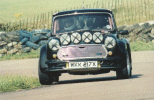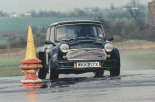 |
At
Lydden Hill near Dover, the car's performance has been tested on tarmac
circuit to see if there is any advantage gained through the additional
traction gained from the 4x4 transmission. In addition, cut slick tyres
have improved run times by around 4 sec's. |

|
Testing
in the wet at Goodwood Race Circuit near Chichester has proved invaluable
to exaggerate any weakness in traction and stability. Speeds of 130mph can
still be achived and any loss of traction must not result in any letting
off the accelerator. |
| 
|
During
the test days at Goodwood, most organising clubs will allow passengers in
the car. This provides one of the few opportunities for me to take out friends
and sponsors in the car and let them participate in a race track experience. |
| 
|
Pictured
here is the car ready to go out on a practice run. Here, the lamp pod on
the front still do not have the spot lights installed, a legacy of the crash
at Lydden. |
| 
|
It
can be clearly seen the amount of water that was on the track that day and
allowed some associates from the London and Surrey Mini Owners Club to experience
the car in the wet. |
| 
|
Probably
the most frequent attended event is at Lydden Hill near Dover. This
is mainly due to the close proximity of the track from home and that the
track licence allows up to 3 cars on the track at the same time. This usually
means that you get at least 5 runs. |
| 
|
Unusually,
Lydden only has 1 main left hand corner. It gives an opportunity for the
suspension and tyre settings to be tested since the right hand tyres are
significantly slower to heat up during a practice or timed run. |
| 
|
The
result of a combination of incorrect suspension settings, incorrect tyre
pressures and a close encounter with a tyre wall. Damage to the front of
the car although was entirely superficial, damage was quite extensive to
the one piece fibreglass front. |
| 
|
With
the aid a friends that were at the race, repairs were carried out in the
pits to enable the car to compete in the remaining practices and timed runs. |
| 
|
At
North Weald Aerodrome near Epping in Essex, testing and races have the added
bonus that there are no tyre walls or gravel trals to worry about. This
gives a excellent opportunity to make the car slide as much as possible
to find the traction break away point. |
| 
|
Pictured
here is the car on its very first competitive outing at Pestalozzi School
in Sussex finishing first in class. Dispite pealing a tyre from its rim,
the car still clocked a faster time on that run than any other car in the
class. |
| 
|
At
the start line at Pestalozzi, spectators get a unique opportunity to see
the car on the start line and appreciate the acceleration from the standing
start with little or no wheelspin. |
| 
|
The
right hand hairpin bend just over half the way up the course, is immediately
after a long fast left. I have found that the best way to negociate the
corner is to slide the car sideways about 30 yards short of the corner and
allow th 4wd to pull the car round. |
| 
|
This
photo taken immediately after the one above, shows how the car does not
have enough lock to drive round the corner and so the back end of the car
is just thrown round to come in line with the front and the continuing track. |
 |
The
cars first event of 1996 was at Valence School hill climb near Sevenoaks.
An excellent day overall with the car winning first in class and "The
Ogden Trophy" presented to the best prepared, presented and engineered
car of the day. Sadly, Valence is no longer a RAC approved hill climb. |

